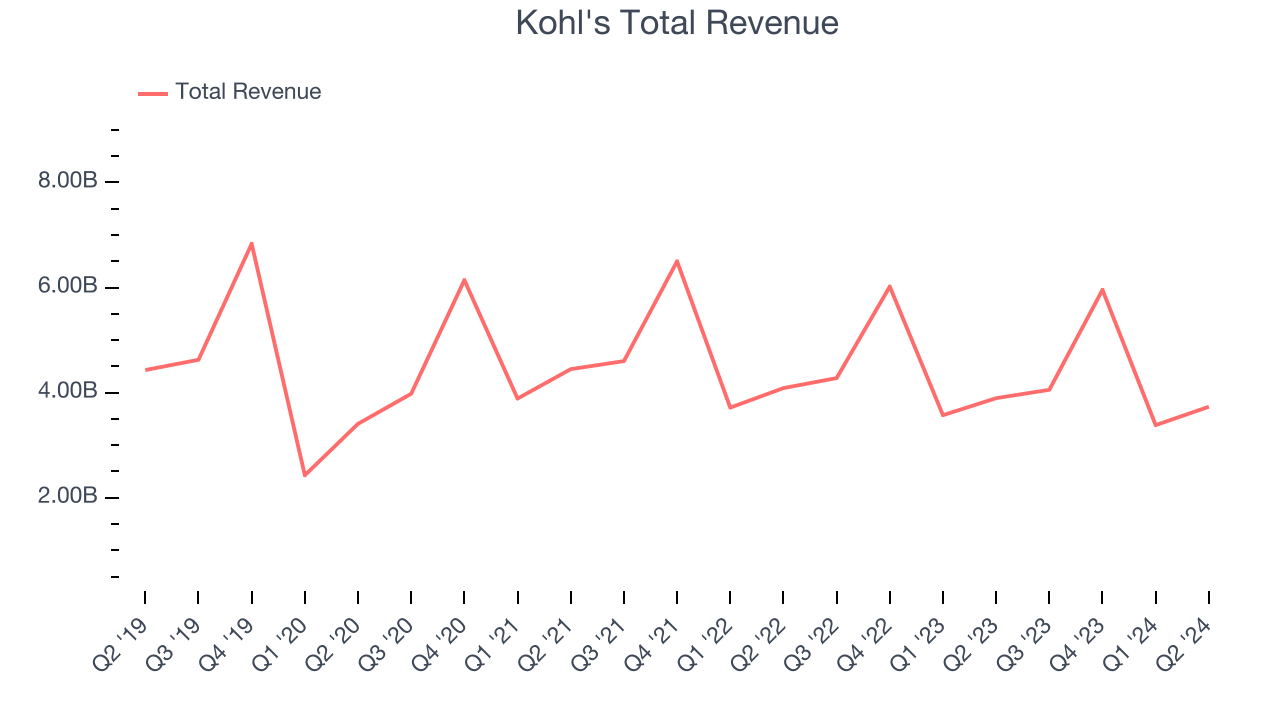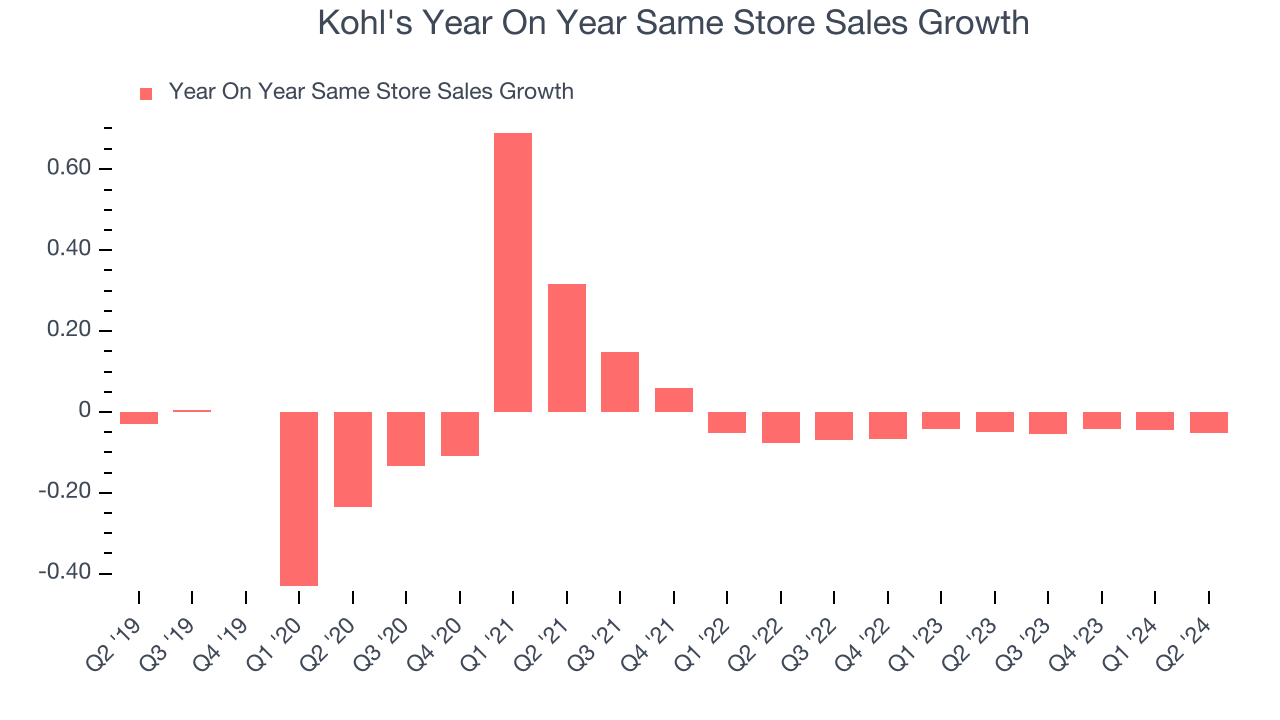Department store chain Kohl’s (NYSE:KSS) beat analysts’ expectations in Q2 CY2024, with revenue down 4.2% year on year to $3.73 billion. It made a GAAP profit of $0.59 per share, improving from its profit of $0.52 per share in the same quarter last year.
Is now the time to buy Kohl's? Find out by accessing our full research report, it’s free.
Kohl's (KSS) Q2 CY2024 Highlights:
- Revenue: $3.73 billion vs analyst estimates of $3.65 billion (2.1% beat)
- EPS: $0.59 vs analyst estimates of $0.44 (35.2% beat)
- EPS (GAAP) guidance for the full year is $2 at the midpoint, beating analyst estimates by 30.9%
- Gross Margin (GAAP): 43%, in line with the same quarter last year
- EBITDA Margin: 9.2%, in line with the same quarter last year
- Free Cash Flow Margin: 3.8%, similar to the same quarter last year
- Same-Store Sales fell 5.1% year on year, in line with the same quarter last year
- Market Capitalization: $2.18 billion
Tom Kingsbury, Kohl’s chief executive officer, said, “We have taken significant action to reposition Kohl’s for future growth. However, our efforts have yet to fully yield the intended outcome due in part to a continued challenging consumer environment and softness in our core business. During the second quarter, our customers exhibited more discretion in their spending, which pressured our sales even as customers transacted more frequently. This overshadowed strong performance in our key growth areas, including Sephora, home decor, gifting, and impulse. In spite of this, we continued to execute well operationally, enabling us to deliver a 13% increase in earnings driven by gross margin expansion and strong inventory and expense management.”
Founded as a corner grocery store in Milwaukee, Wisconsin, Kohl’s (NYSE:KSS) is a department store chain that sells clothing, cosmetics, electronics, and home goods.
Department Store
Department stores emerged in the 19th century to provide customers with a wide variety of merchandise under one roof, offering a convenient and luxurious shopping experience. They played an important role in the history of American retail and urbanization, and prior to department stores, retailers tended to sell narrow specialty and niche items. But what was once new is now old, and department stores are somewhat considered a relic of the past. They are being attacked from multiple angles–stagnant foot traffic at malls where they’ve served as anchors; more nimble off-price and fast-fashion retailers; and e-commerce-first competitors not burdened by large physical footprints.
Sales Growth
Kohl's is one of the larger companies in the consumer retail industry and benefits from economies of scale, enabling it to gain more leverage on fixed costs and offer consumers lower prices.
As you can see below, the company’s revenue has declined over the last four years, dropping 3% annually as it failed to grow its store footprint meaningfully and observed lower sales at existing, established stores.

This quarter, Kohl’s revenue fell 4.2% year on year to $3.73 billion but beat Wall Street’s estimates by 2.1%. Looking ahead, Wall Street expects revenue to decline 4% over the next 12 months.
Today’s young investors won’t have read the timeless lessons in Gorilla Game: Picking Winners In High Technology because it was written more than 20 years ago when Microsoft and Apple were first establishing their supremacy. But if we apply the same principles, then enterprise software stocks leveraging their own generative AI capabilities may well be the Gorillas of the future. So, in that spirit, we are excited to present our Special Free Report on a profitable, fast-growing enterprise software stock that is already riding the automation wave and looking to catch the generative AI next.
Same-Store Sales
Same-store sales growth is an important metric that tracks demand for a retailer’s established brick-and-mortar stores and e-commerce platform.
Kohl’s demand has been shrinking over the last eight quarters, and on average, its same-store sales have declined by 5.3% year on year. This performance is quite concerning and the company should reconsider its strategy before investing its precious capital into new store buildouts.

In the latest quarter, Kohl’s same-store sales fell 5.1% year on year. This performance was more or less in line with the same quarter last year.
Key Takeaways from Kohl’s Q2 Results
We were impressed by how significantly Kohl's blew past analysts’ EPS expectations this quarter. We were also excited its full-year earnings guidance topped Wall Street’s estimates. Zooming out, we think this was a solid quarter. The stock traded up 3.2% to $20.23 immediately following the results.
Kohl's may have had a good quarter, but does that mean you should invest right now? When making that decision, it’s important to consider its valuation, business qualities, as well as what has happened in the latest quarter. We cover that in our actionable full research report which you can read here, it’s free.
